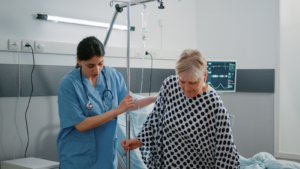Congress Newsletter 2022
ESAIC Honorary Member – Prof. Doris Østergaard

Q: Congratulations on your Honorary Membership Doris. As we ask all our new Honorary Members, tell us how you felt when you heard you would receive this honour?
A: At first, I was very surprised, and next I felt very honoured. I started thinking of why this honour and thought that it might be due to all the new things happening in the Simulation Committee and previous work in the Patient Safety Committee. It is a great privilege to work with engaged team members in both committees. I have enjoyed my time as associate editor of the EJA. The former Editor-in-Chief, Martin Tramer and the team were working hard to improve the impact of the journal, and I learned a lot from them.
Q: For our members who don’t know you well, please tell us a little about your early career, where you trained and what made you decide to specialise in anaesthesiology?
A: I became interested in anaesthesiology already in my clinical rotation there when I was a medical student at the university. I started my training at Herlev University Hospital and became involved in research with Professor Jørgen Viby Mogensen, who was an excellent mentor for the research group. My first studies were about neuromuscular blocking drugs and monitoring. The topic of my thesis was the Influence of plasma cholinesterase activity and phenotype on the pharmacodynamics and pharmacokinetics of mivacurium. Some of these studies could only be conducted in Denmark, where we have a national registry of these patients. Professor Viby Mogensen introduced me to researchers within these fields all over the world, a network that I really appreciate.
Q: What would you say have been the most impactful changes in anaesthesiology during your career?
A: Anaesthesiology is famous for its focus on patient safety and education. During the last 50 years, the safety for patients has increased significantly due to technological development which has made it possible to monitor the patients better. We now have drugs with shorter half-lives and fewer side effects. In addition, we have a better understanding of human factors and how we can train both individual medical expertise skills and social and cognitive skills in multi-professional teams. We can train without endangering the patient in a safe environment in the simulated setting. Many types of simulations are now available.
Q: Tell us about some important studies you have been involved in during your career?
A: The studies in patients heterozygous or homozygous for atypical plasma cholinesterase gave important insight in how different the pharmacokinetics and pharmacodynamics were in these patients. The very prolonged duration of action was a surprise.
Research in education and simulation-based training helped us to understand how important it is to create a safe learning environment and train the trainers in how to use simulation and conduct a debriefing to create room for reflection. In addition, the further development of behavioural markers for anaesthesia non-technical skills such as ANTS.dk to be used in the danish context.
Recently, there is an increase in burnout among clinicians and reports show a problem with staff members’ mental health. We are conducting a study in a department of anaesthesia to see if we can improve mental health by introducing structured communications and defusing.
Q: Today, one of your areas of focus is using simulation-based training to improve patient safety, and indeed you are Chair of the Simulation Committee in the European Society of Anaesthesiology and Intensive Care. How did you first become involved in Simulation?
A: I became involved in education very early in my career and later in simulation-based training at Herlev University Hospital, where a Danish anaesthesia simulator was developed in the early 1990s. The activities grew and became available for staff in the hospital. Now we are a regional centre with responsibilities for specialist training activities for many professions and specialities. We are involved in many research activities to help improve the training activities and the transfer of the learning to the clinical environment. At the moment we are looking at continuous professional development too.
Recently, we have been engaged in how to facilitate the transfer of activities to new environments and avoid endangering the patients by analyzing work in the new environment before for example a new emergency unit is taken into use and to train staff in working there.
Q: Tell me about some of the aims you have for the rest of your career?
A: I hope to see some of the planned projects in the simulation committee be successfully implemented, for example together with the Romanian Society to facilitate the implementation of simulation-based training for all residents. We also have plans for fellowships and masterclasses in simulation. On a personal level, I hope to continue research within this field.
Q: What are some of the sessions you would like to see at this year’s Congress? Will you be attending the SIMLAB and Serious Games sessions?
A: Many of the simulation committee members are involved in both SIMLAB together with dedicated facilitators from many countries in Europe, they are doing a great job. I hope, that we can make new scenarios together with some of the scientific committees every year, to create new learning opportunities at the coming Euroanaesthesia congresses. Serious Games is a new interesting initiative, I am looking forward to seeing them!
Thanks so much Doris and congratulations on your Honorary Membership.
Read More of our special newsletter covering our congress.










